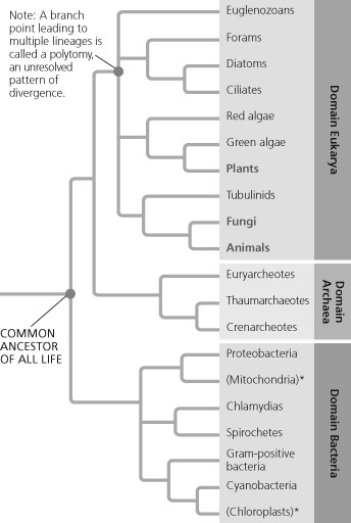Multiple Choice

A phylogenetic tree is shown for the three domains of life (Eukarya, Archaea, and Bacteria) . The tree branches in two directions from the first point, labeled Common ancestor of all life. One branch leads in the direction of Eukarya and Archaea, and the other branch leads to Bacteria. The branch leading to Eukarya and Archaea divide, one branch leading to each domain. The branch leading to Eukarya divides into four branches. One leads to Euglenozoans, and the other three lead to branching points. The first leads to Forams in one direction, and another branching point in the other that leads to Diatoms and Ciliates. The second branching point leads to Red algae in one direction, and a branching point that leads to green algae and land plants in the other direction. The third branching point leads to amoebas in one direction, and a branching point that leads to fungi and animals in the other direction. Land plants, Fungi and Animals are all highlighted.
Cyanobacteria were once called blue-green algae because they are photosynthetic. According to the phylogeny shown, the cyanobacteria are more closely related to gram-positive bacteria than to ________.
A) proteobacteria
B) green algae
C) euglenozoans
D) crenarcheotes
Correct Answer:

Verified
Correct Answer:
Verified
Q3: Which eukaryotic kingdom includes members that are
Q42: Eukaryotes that are not closely related and
Q44: Phylogenetic trees constructed from evidence from molecular
Q45: Use the figure to answer the following
Q46: If, someday, an archaean cell is discovered
Q48: Use the following information to answer the
Q49: Which of the following statements best describes
Q50: The kingdom Monera was dismantled because of
Q51: The various taxonomic levels (for example, phyla,
Q52: Some molecular data place the giant panda